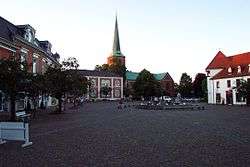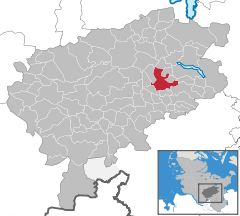Bad Segeberg
| Bad Segeberg | ||
|---|---|---|
 | ||
| ||
 Bad Segeberg | ||
Location of Bad Segeberg within Segeberg district 
 | ||
| Coordinates: 53°55′N 10°19′E / 53.917°N 10.317°ECoordinates: 53°55′N 10°19′E / 53.917°N 10.317°E | ||
| Country | Germany | |
| State | Schleswig-Holstein | |
| District | Segeberg | |
| Government | ||
| • Mayor | Hans-Joachim Hampel (CDU) | |
| Area | ||
| • Total | 18.87 km2 (7.29 sq mi) | |
| Population (2015-12-31)[1] | ||
| • Total | 17,176 | |
| • Density | 910/km2 (2,400/sq mi) | |
| Time zone | CET/CEST (UTC+1/+2) | |
| Postal codes | 23781–23795 2360 | |
| Dialling codes | 04551 | |
| Vehicle registration | SE | |
| Website | www.badsegeberg.de | |
Bad Segeberg is a German town of 16,000 inhabitants, located in the state of Schleswig-Holstein, capital of the district (Kreis) Segeberg. It is situated approximately 50 kilometers (31 mi) northeast of Hamburg, and 25 kilometers (16 mi) west of Lübeck.
It is famous for its annual Karl May Festival. It takes place in the city's Kalkberg Stadium, a large amphitheater originally built by the Reich Labour Service into an exploited quarry at the Segeberger Kalkberg.
There is a large television tower in the middle of the city.
Sons and daughters of the town
- Detlev Buck, (born 1962), actor, film director and producer
- Maria Jepsen, (born 1945), Lutheran bishop
- Janek Sternberg, (born 1992), footballer
- Mona Barthel, (born 1990), tennis player
Twin towns — sister cities
Bad Segeberg is twinned with:
 Złocieniec, Poland
Złocieniec, Poland Riihimäki, Finland
Riihimäki, Finland Kiryat Motzkin, Israel
Kiryat Motzkin, Israel Teterow, Germany
Teterow, Germany Võru, Estonia
Võru, Estonia Grand Island, United States
Grand Island, United States
| Wikimedia Commons has media related to Bad Segeberg, Germany. |
References
This article is issued from Wikipedia - version of the 10/23/2016. The text is available under the Creative Commons Attribution/Share Alike but additional terms may apply for the media files.
